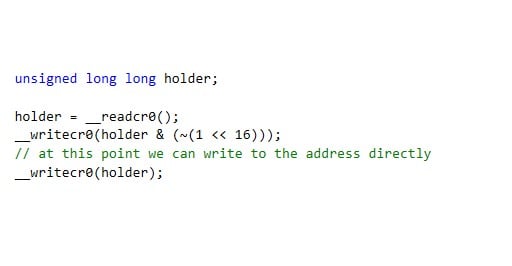
In this article, we’ll present a new hooking technique that we have found during our research work.
Hooking techniques give you control over the way an operating system or a piece of software behaves. Some of the software that utilizes hooks include: application security solutions, system utilities, tools for programming (e.g. interception, debugging, extending software, etc.), malicious software (e.g. rootkits) and many others.
Please note, this is neither an elevation nor an exploitation technique. This technique can be used in a post-exploitation scenario in which the attacker has control over the asset. Since malicious kernel code (rootkits) often seeks to establish persistence in unfriendly territory, stealth technology plays a fundamental role.
Technical Description
The idea behind this BoundHook technique is to cause an exception in a very specific location in a user-mode context and catch the exception to gain control over the thread execution.
To do this, we can use the BOUND instruction, which is part of Intel MPX (Memory Protection Extensions). This instruction is designed to (along with the compiler, runtime libraries and OS support) increase software security by checking pointer references whose normal compile-time intentions are maliciously exploited at runtime due to memory corruption vulnerabilities.
In a nutshell, the BOUND instruction checks an array index against bounds and raises software interrupt 5 if the test fails (32-bit: nt!KiTrap05, 64-bit: nt!KiBoundFault).
Why not just do a comparison, you ask? Because Intel designed this new instruction to generate a fault that will enable the OS to examine the bound check failure.

The instruction’s syntax is as follows –
BOUND r16, m16&16 – Checks if r16 (array index) is within bounds specified by m16&16
BOUND r32, m32&32 – Checks if r32 (array index) is within bounds specified by m32&32
When a bound fault occurs, the trap handler calls nt!KiHandleBound and then executes registered bounds-exception callback routines.
A kernel-mode driver or a shellcode payload running in kernel-mode can register a callback routine for bound faults using nt!KeRegisterBoundCallback. This function is not “exported” by the WDK headers, and a pointer to the function has to be obtained dynamically.
The callback routine has no parameters and should return a BOUND_CALLBACK_STATUS, which is basically:

After completion of the bound fault registration, the kernel-mode code should get a pointer to the user-mode DLL (or any other PE) base address and calculate the address of the function that it’s about to hook.
Obtaining a function address is a simple task and can be accomplished in various ways, for example by parsing the PE header. Please note, parsing an image that is loaded into a specific process should be done in the process’s context or using the appropriate APIs.
Once our code is done calculating the function address, it would be nice to simply start writing to that address. However, because this code resides in read/execute only memory, we are unable to do this.
Windows memory protection relies on the following factors:
- The R/W flag in PDEs and PTEs (read only = 0, read/write = 1).
- The U/S flag in PDEs and PTEs (supervisor mode = 0, user mode = 1).
- The WP flag in the CR0 register (17th bit).
Now, we have a few options. We can either write to that address in a way that would trigger the COW (copy-on-write) protection or, to achieve maximum stealth, we can write directly to the function address in one of two ways. We can either manipulate the CR0 register using __readcr0() and __writecr0(), or we can allocate our own memory descriptor list (MDL) to describe the memory pages and adjust permissions on the MDL using a bitwise OR and the MDL_MAPPED_TO_SYSTEM_VA. The MDL approach will be much more “stealthy”, since it’s completely invisible by design to the current PatchGuard implementation.
First, here’s how we can use the CR0 approach. The CR0 register description, taken from the Intel 64 and IA-32 Architectures Software Developer’s Manual reads:
“WP Write Protect (bit 16 of CR0) — When set, inhibits supervisor-level procedures from writing into readonly pages; when clear, allows supervisor-level procedures to write into read-only pages (regardless of the U/S bit setting; see Section 4.1.3 and Section 4.6).”
Here is an example of cr0 register manipulation:

Writing directly to the DLL’s COW page will allow us to hook every process on the system that is using this DLL since it will affect the cow-origin page.
Triggering a bound fault is easy. For example, this code will trigger a fault:
Thus, our kernel-mode code that performs the hooking should write a similar assembly code to the place where it wants to get control over the execution of the thread.
For example, if we want to hook KERNELBASE!CreateFileW, we can inject these opcodes to the function’s prologue:
UCHAR opcodes[5]= {0x36, 0x66, 0x62, 0x0C, 0x24};
This is basically: BOUND CX, DWORD PTR SS : [ESP]. In this specific case, we assume that CX will be zero (when used in real code this should be tested for every function) and the top of stack will be greater than zero (as this is a proof of concept and not a released tool).
Now, after writing this to the KERNELBASE!CreateFileW prologue, when a user-mode thread calls this function our kernel-mode callback function will take control of the thread.
Doing this, gives us a lot of advantages, for example –
- The hooked page will still be COW, thus anti-malware solutions and researchers doing manual analysis won’t be able to notice that the page has been modified.
- Most AVs are unaware of this method and probably aren’t addressing it (especially since the page is still COW).
- A user-mode debugger will not be able to catch this hook. A regular inline hook method makes the hooked routine jump to another user-mode code, but BoundHook’s method traps the execution flow by the kernel bound faults handler.
- This method is invisible to most PatchGuard (PG) protection mechanisms. The MDL approach to bypass the COW mechanism is not detectable by PG today by design. As for the CR0 modification approach, although the CR0 is protected by PG, since it is modified for a very short period of time, the chance of being caught by PG is minimal.
Proof-of-concept, a call stack of a hooked thread:

We know that BoundHook does not meet Microsoft’s bar to be considered a vulnerability, as machine administrator rights are already compromised. Microsoft’s response on receiving responsible notification of a similar issue from CyberArk (GhostHook) was as follows:
“We have completed our investigation of this issue and have found that it is not a vulnerability but a technique to avoid detection once the machine is already compromised. Because it’s a post-exploitation technique it doesn’t meet the bar for servicing in a security update but we will consider fixing it in a future version of Windows.”
In conclusion, this method will bring new capabilities to both software security vendors and malware writers.























